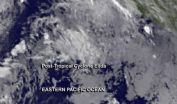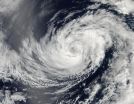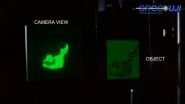(Press-News.org) Ecologist Thomas Mueller uses satellite data to study how the patterns of plant growth relate to the movement of caribou and gazelle. The research sparked an idea: Would the footprint of human activity show up in the data?
Mueller, of the University of Maryland in College Park (now at the Biodiversity and Climate Research Center in Frankfurt) teamed up with university and NASA colleagues to find out. Their new analysis shows that on a global scale, the presence of people corresponds to more plant productivity, or growth.
Specifically, populated areas that have undergone intensive land use showed increasing plant greenness and productivity during the study period from 1981 to 2010. The research was published June 18 in Remote Sensing.
"Earth's land surface has been changed across very broad scales," Mueller said. "Human intervention has increased plant growth over large areas where intensification of agriculture has occurred."
The finding doesn't imply that relatively small areas with massive populations like New York City, with a high population density, are necessarily flourishing in increasingly abundant greenery. Rather, the study uses an existing classifications of the planet's land surface based on how it's impacted by people, including the dense settlements, villages and croplands that compose 28 percent of Earth's ice-free land surface. The rest of the land surface is categorized as forested, rangelands or wildlands.
The researchers used data from NOAA's Advanced Very High Resolution Radiometers (AVHRR), onboard a series of polar-orbiting satellites, and NASA's Moderate Resolution Imaging Spectroradiometer (MODIS) instruments, on the Terra and Aqua satellites, which produce a vegetation index that allows scientists to track changes in plant growth over large areas.
"We are fortunate to have 30 years of global vegetation greenness data from satellites to perform studies such as these," said Compton Tucker a co-author on the study at NASA's Goddard Space Flight Center in Greenbelt, Maryland.
The researchers found that the magnitude of changes in plant growth over the 29-year study period was different depending on the size of nearby population. Near areas defined as dense settlements – with about 500 people per square kilometer – the vegetation index increased by 4.3 percent. That's less than near villages, where the vegetation index increased by almost 6 percent. "More intensive agriculture occurs in these rural areas," Tucker added.
In short, areas with a human footprint have seen plant productivity increase. In contrast, areas with a minimal human footprint – rangelands and wildlands – saw close to no change.
Next, the team used a statistical analysis to estimate the relative importance of the various causes of changes in productivity. They showed that human-caused factors such as land use, nitrogen fertilization and irrigation accounted for much of the growth changes since 1981 in the areas studied.
The study follows on the heels of related research that showed the impact of climate on land plants at higher northern latitudes, where winter temperatures restrict the growing season, which researchers called the "warmer Earth, greener north" phenomenon. Agricultural areas were excluded from the higher northern latitude studies. "We now know that in addition to warmer climate at higher northern latitudes, human land use at lower latitudes also has a detectable, global footprint on Earth's vegetation growth," Tucker said.
INFORMATION:
More people means more plant growth, NASA data shows
2014-07-02
ELSE PRESS RELEASES FROM THIS DATE:
Wind shear wipes out Tropical Cyclone Elida
2014-07-02
Strong northwesterly wind shear took its toll on Tropical Storm Elida, weakening it to a remnant low early on July 2. In infrared satellite imagery from NOAA's GOES-West satellite, Elida appeared to be a tight swirl of low clouds devoid of any deep convection.
Infrared satellite instruments are used to see the heat objects emit. During night-time hours when there's no sunlight to light clouds, satellites like NOAA's Geostationary Operational Environmental Satellite or GOES-West satellite looks at clouds in infrared light. Infrared data from NOAA's GOES-West satellite ...
Georgia Tech researchers develop 'Encore' to monitor Web access
2014-07-02
Georgia Tech researchers have created a tool to monitor the accessibility of Web pages around the world that can be installed by adding a single line of code to a web page. The tool, Encore, runs when a user visits a website where the code is installed and then discreetly collects data from potentially censored sites.
The researchers hope the data they collect will allow them to determine the wheres, whens and hows of what's blocked, as well as identify ways to get around restricted access.
"Web censorship is a growing problem affecting users in an increasing number ...
NASA's TRMM satellite spots heavy rainfall around Tropical Storm Arthur's center
2014-07-02
Tropical Storm Arthur appears to be ramping up, and NASA's Tropical Rainfall Measuring Mission or TRMM satellite spotted heavy rainfall occurring around the storm's center on July 1 when it was centered over the Bahamas.
Those heavy rains are expected to affect the southern U.S. coastline over the next several days as the National Hurricane Center expects Arthur to strengthen into a hurricane. On July 2, the NHC issued a Hurricane Watch for Bogue Inlet to Oregon Inlet, North Carolina and Pamlico Sound. In addition, a Tropical Storm Watch is in effect for the east coast ...
NASA sees a weaker Tropical Storm Douglas
2014-07-02
NASA's Aqua satellite captured a picture of Tropical Storm Douglas as it began moving into cooler waters in the Eastern Pacific Ocean. Those cooler waters, coupled with drier air are expected to bring about the storm's demise, according to the National Hurricane Center.
A visible image of Tropical Storm Douglas was taken by the Moderate Resolution Imaging Spectroradiometer or MODIS instrument aboard NASA's Aqua satellite on July 1 at 21:20 UTC (5:20 p.m. EDT). The thickest band of thunderstorms appeared over the southern semi-circle of the weakening storm while bands ...
Squid sucker ring teeth material could aid reconstructive surgery, serve as eco-packaging
2014-07-02
Squid tentacles are loaded with hundreds of suction cups, or suckers, and each sucker has a ring of razor-sharp "teeth" that help these mighty predators latch onto and take down prey. In a study published in the journal ACS Nano, researchers report that the proteins in these teeth could form the basis for a new generation of strong, but malleable, materials that could someday be used for reconstructive surgery, eco-friendly packaging and many other applications.
Ali Miserez and colleagues explain that in previous research, they discovered that sharp, tough squid sucker ...
'Green buildings' have potential to improve health of low-income housing residents
2014-07-02
The "green building" trend is often associated with helping the environment by using eco-friendly materials and energy-saving techniques, but these practices are designed to improve people's health, too. Now scientists are reporting evidence that they can indeed help people feel better, including those living in low-income housing. Published in ACS' journal Environmental Science & Technology, the study found that certain health problems of public housing residents who moved into green buildings noticeably improved.
Gary Adamkiewicz, Meryl Colton and colleagues note that ...
Toward a new way to keep electronics from overheating
2014-07-02
Computer technology has transformed the way we live, but as consumers expect ever more from their devices at faster speeds, personal computers as well as larger electronic systems can overheat. This can cause them to slow down, or worse, completely shut down. Now researchers are reporting in the ACS journal Industrial & Engineering Chemistry Research that liquids containing nanoparticles could help devices stay cool and keep them running.
Rahman Saidur and colleagues point out that consumers demand a lot out of their gadgets. But that puts a huge strain on the tiny parts ...
Overcoming light scattering: New optical system sees deeper inside tissue
2014-07-02
VIDEO:
After the diffuser, the information content of the object is scrambled so that the light distribution at the pixelated sensor looks like the familiar speckle noise.
Click here for more information.
Optical imaging methods are rapidly becoming essential tools in biomedical science because they're noninvasive, fast, cost-efficient and pose no health risks since they don't use ionizing radiation. These methods could become even more valuable if researchers could find a way ...
Becoming an expert takes more than practice
2014-07-02
Deliberate practice may not have nearly as much influence in building expertise as we thought, according to research published in Psychological Science, a journal of the Association for Psychological Science.
Scientists have been studying and debating whether experts are "born" or "made" since the mid-1800s. In recent years, deliberate practice has received considerable attention in these debates, while innate ability has been pushed to the side, due in part to the famous "10,000-hour rule" coined by Malcolm Gladwell in his 2008 book Outliers.
The new study, from psychological ...
Joslin scientists identify process that affects fat distribution and metabolic syndrome
2014-07-02
BOSTON – July 1, 2014 – Building upon their earlier research on the biology of fat metabolism, Joslin scientists discovered that microRNAs –small RNA molecules that play important roles in regulation in many types of tissue – play a major role in the distribution and determination of fat cells and whole body metabolism. Also, the study is the first to reveal that microRNAs (miRNAs) influence the development of lipodystrophy (abnormal fat accumulation) which affects many people with HIV receiving anti-retroviral therapy. The findings appear in the August issue of the Journal ...





